Creating an Inclusive Playing Field: A Report on Inclusive Practice
VerifiedAdded on 2023/06/18
|12
|3488
|240
Report
AI Summary
This report provides an in-depth analysis of creating an inclusive playing field within the context of inclusive practice, specifically focusing on Geography and History. It begins by examining the impact of social, cultural, and personal factors, as well as physical, sensory, and cognitive skills, on learning. The report summarizes the policy and regulatory framework related to inclusive practice, discussing how these policies affect organizational policies and individual performance. It further explores roles and responsibilities in relation to inclusive practice, highlighting the involvement of various professionals and identifying referral points to meet individual learning needs. The features and benefits of an inclusive learning environment are outlined, along with strategies for effective liaison between professionals. The report analyzes ways to promote equality, value diversity, and foster inclusion, concluding with a discussion of the effectiveness of inclusive practices, identification of personal strengths and areas for improvement, and a plan for enhancing relevant skills. The goal is to provide accessible content, demonstrate knowledge effectively, and ensure full engagement in learning activities for all students.
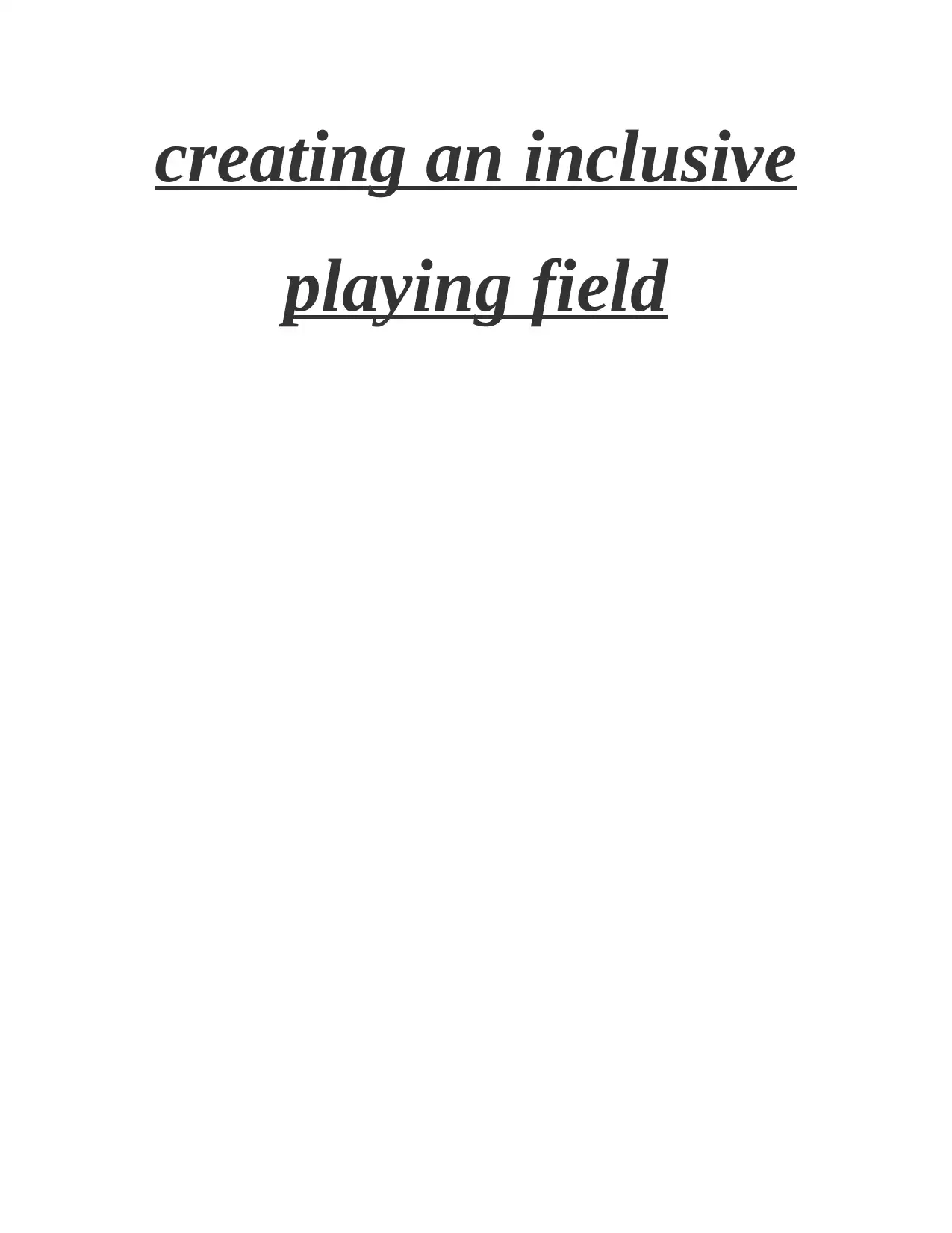
creating an inclusive
playing field
playing field
Paraphrase This Document
Need a fresh take? Get an instant paraphrase of this document with our AI Paraphraser

Table of Contents
INTRODUCTION...........................................................................................................................................3
TASK 1..........................................................................................................................................................3
1.1Impact of social, cultural and personal factors on learning.................................................................3
1.2 Discuss impact of Physical, sensory, and cognitive skills on learning.........................................4
2.1 Summarize the policy and regulatory framework related to inclusive practice..................................4
2.2 Discuss how policies affect organizational policies of inclusive practice..........................................4
2.3Discuss the influence of inclusive practice on own performance........................................................5
TASK 2..........................................................................................................................................................5
3.1 Discuss own roles and responsibilities in relation of inclusive practice.............................................5
3.2 Explain role of own and other professional involve in the inclusive practice....................................6
3.3 Identify points of referral to meet with learning needs of individuals................................................6
4.1features addition to benefits of inclusive learning environment..........................................................6
4.4 Strategies of effective liaison between professionals involved in the practice of inclusion...............7
TASK 3..........................................................................................................................................................7
4.2 Analysing ways for promoting equality together with value diversity...............................................7
4.3 Analysing ways for promoting inclusion...........................................................................................8
5.1 Discuss the effectiveness of own inclusive practice...........................................................................8
5.2 Identify own strengths and areas of improvements in context of inclusive practice..........................9
5.3 Discuss plan of opportunities to improve own skills........................................................................10
Conclusion.................................................................................................................................................11
References.................................................................................................................................................12
INTRODUCTION...........................................................................................................................................3
TASK 1..........................................................................................................................................................3
1.1Impact of social, cultural and personal factors on learning.................................................................3
1.2 Discuss impact of Physical, sensory, and cognitive skills on learning.........................................4
2.1 Summarize the policy and regulatory framework related to inclusive practice..................................4
2.2 Discuss how policies affect organizational policies of inclusive practice..........................................4
2.3Discuss the influence of inclusive practice on own performance........................................................5
TASK 2..........................................................................................................................................................5
3.1 Discuss own roles and responsibilities in relation of inclusive practice.............................................5
3.2 Explain role of own and other professional involve in the inclusive practice....................................6
3.3 Identify points of referral to meet with learning needs of individuals................................................6
4.1features addition to benefits of inclusive learning environment..........................................................6
4.4 Strategies of effective liaison between professionals involved in the practice of inclusion...............7
TASK 3..........................................................................................................................................................7
4.2 Analysing ways for promoting equality together with value diversity...............................................7
4.3 Analysing ways for promoting inclusion...........................................................................................8
5.1 Discuss the effectiveness of own inclusive practice...........................................................................8
5.2 Identify own strengths and areas of improvements in context of inclusive practice..........................9
5.3 Discuss plan of opportunities to improve own skills........................................................................10
Conclusion.................................................................................................................................................11
References.................................................................................................................................................12
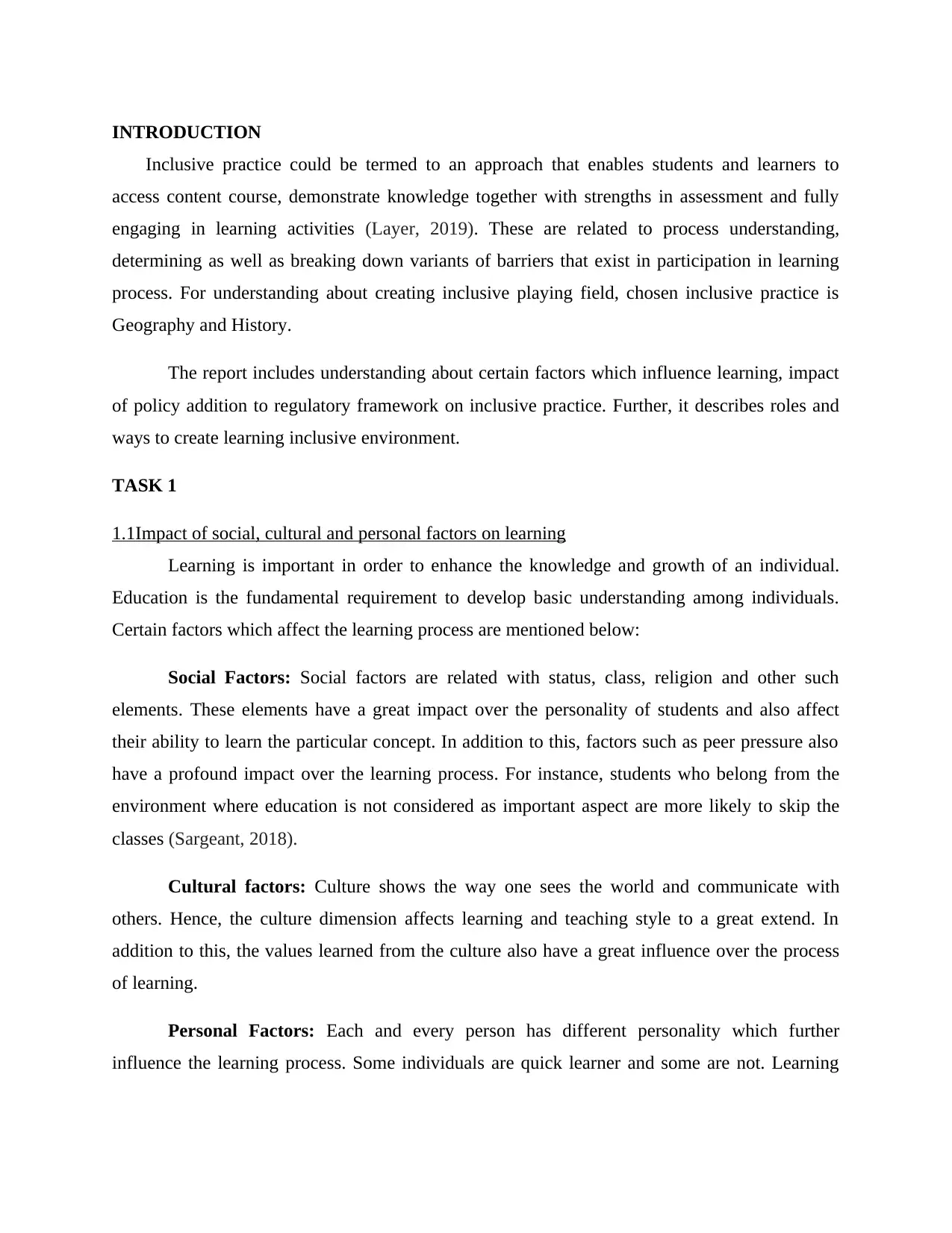
INTRODUCTION
Inclusive practice could be termed to an approach that enables students and learners to
access content course, demonstrate knowledge together with strengths in assessment and fully
engaging in learning activities (Layer, 2019). These are related to process understanding,
determining as well as breaking down variants of barriers that exist in participation in learning
process. For understanding about creating inclusive playing field, chosen inclusive practice is
Geography and History.
The report includes understanding about certain factors which influence learning, impact
of policy addition to regulatory framework on inclusive practice. Further, it describes roles and
ways to create learning inclusive environment.
TASK 1
1.1Impact of social, cultural and personal factors on learning
Learning is important in order to enhance the knowledge and growth of an individual.
Education is the fundamental requirement to develop basic understanding among individuals.
Certain factors which affect the learning process are mentioned below:
Social Factors: Social factors are related with status, class, religion and other such
elements. These elements have a great impact over the personality of students and also affect
their ability to learn the particular concept. In addition to this, factors such as peer pressure also
have a profound impact over the learning process. For instance, students who belong from the
environment where education is not considered as important aspect are more likely to skip the
classes (Sargeant, 2018).
Cultural factors: Culture shows the way one sees the world and communicate with
others. Hence, the culture dimension affects learning and teaching style to a great extend. In
addition to this, the values learned from the culture also have a great influence over the process
of learning.
Personal Factors: Each and every person has different personality which further
influence the learning process. Some individuals are quick learner and some are not. Learning
Inclusive practice could be termed to an approach that enables students and learners to
access content course, demonstrate knowledge together with strengths in assessment and fully
engaging in learning activities (Layer, 2019). These are related to process understanding,
determining as well as breaking down variants of barriers that exist in participation in learning
process. For understanding about creating inclusive playing field, chosen inclusive practice is
Geography and History.
The report includes understanding about certain factors which influence learning, impact
of policy addition to regulatory framework on inclusive practice. Further, it describes roles and
ways to create learning inclusive environment.
TASK 1
1.1Impact of social, cultural and personal factors on learning
Learning is important in order to enhance the knowledge and growth of an individual.
Education is the fundamental requirement to develop basic understanding among individuals.
Certain factors which affect the learning process are mentioned below:
Social Factors: Social factors are related with status, class, religion and other such
elements. These elements have a great impact over the personality of students and also affect
their ability to learn the particular concept. In addition to this, factors such as peer pressure also
have a profound impact over the learning process. For instance, students who belong from the
environment where education is not considered as important aspect are more likely to skip the
classes (Sargeant, 2018).
Cultural factors: Culture shows the way one sees the world and communicate with
others. Hence, the culture dimension affects learning and teaching style to a great extend. In
addition to this, the values learned from the culture also have a great influence over the process
of learning.
Personal Factors: Each and every person has different personality which further
influence the learning process. Some individuals are quick learner and some are not. Learning
⊘ This is a preview!⊘
Do you want full access?
Subscribe today to unlock all pages.

Trusted by 1+ million students worldwide
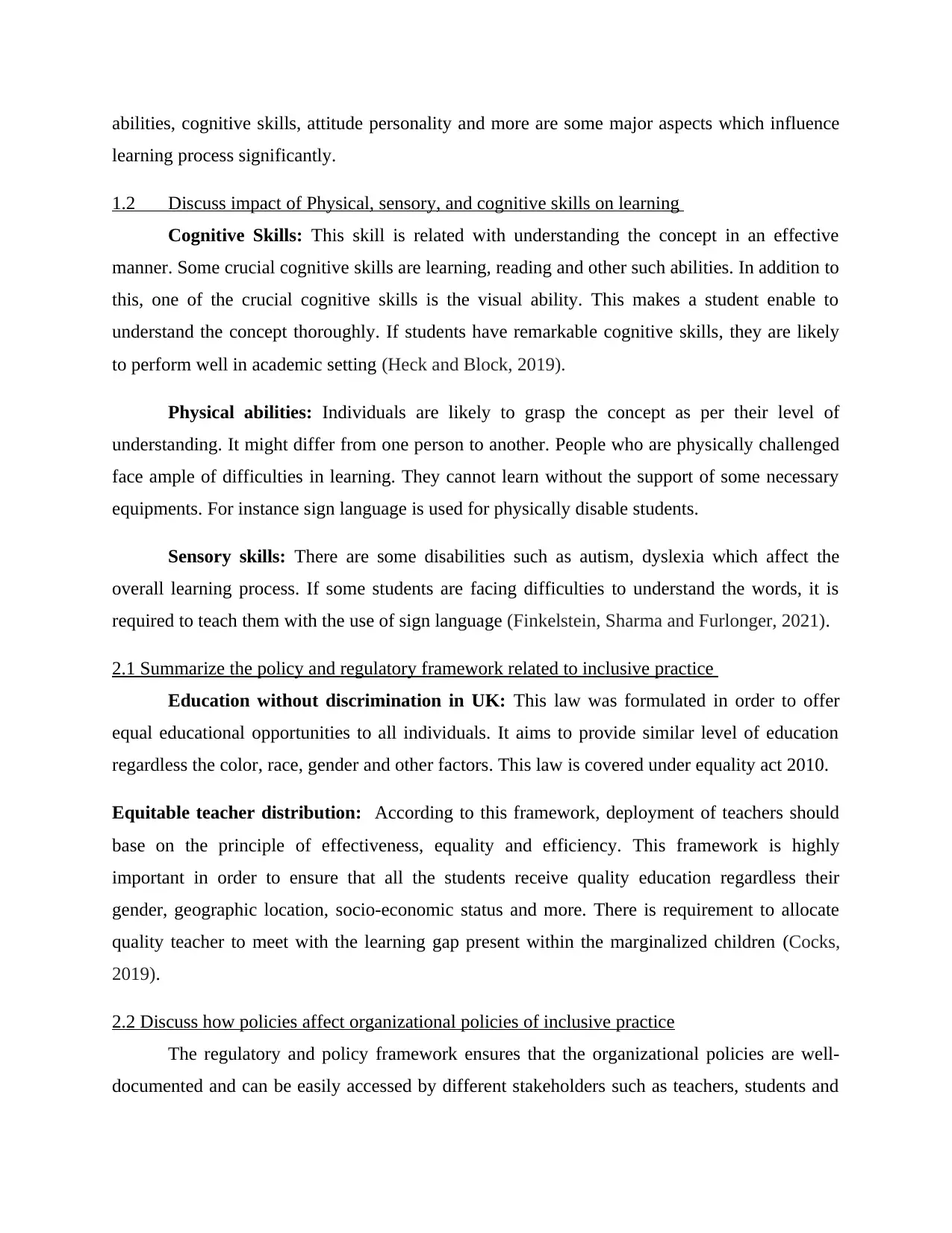
abilities, cognitive skills, attitude personality and more are some major aspects which influence
learning process significantly.
1.2 Discuss impact of Physical, sensory, and cognitive skills on learning
Cognitive Skills: This skill is related with understanding the concept in an effective
manner. Some crucial cognitive skills are learning, reading and other such abilities. In addition to
this, one of the crucial cognitive skills is the visual ability. This makes a student enable to
understand the concept thoroughly. If students have remarkable cognitive skills, they are likely
to perform well in academic setting (Heck and Block, 2019).
Physical abilities: Individuals are likely to grasp the concept as per their level of
understanding. It might differ from one person to another. People who are physically challenged
face ample of difficulties in learning. They cannot learn without the support of some necessary
equipments. For instance sign language is used for physically disable students.
Sensory skills: There are some disabilities such as autism, dyslexia which affect the
overall learning process. If some students are facing difficulties to understand the words, it is
required to teach them with the use of sign language (Finkelstein, Sharma and Furlonger, 2021).
2.1 Summarize the policy and regulatory framework related to inclusive practice
Education without discrimination in UK: This law was formulated in order to offer
equal educational opportunities to all individuals. It aims to provide similar level of education
regardless the color, race, gender and other factors. This law is covered under equality act 2010.
Equitable teacher distribution: According to this framework, deployment of teachers should
base on the principle of effectiveness, equality and efficiency. This framework is highly
important in order to ensure that all the students receive quality education regardless their
gender, geographic location, socio-economic status and more. There is requirement to allocate
quality teacher to meet with the learning gap present within the marginalized children (Cocks,
2019).
2.2 Discuss how policies affect organizational policies of inclusive practice
The regulatory and policy framework ensures that the organizational policies are well-
documented and can be easily accessed by different stakeholders such as teachers, students and
learning process significantly.
1.2 Discuss impact of Physical, sensory, and cognitive skills on learning
Cognitive Skills: This skill is related with understanding the concept in an effective
manner. Some crucial cognitive skills are learning, reading and other such abilities. In addition to
this, one of the crucial cognitive skills is the visual ability. This makes a student enable to
understand the concept thoroughly. If students have remarkable cognitive skills, they are likely
to perform well in academic setting (Heck and Block, 2019).
Physical abilities: Individuals are likely to grasp the concept as per their level of
understanding. It might differ from one person to another. People who are physically challenged
face ample of difficulties in learning. They cannot learn without the support of some necessary
equipments. For instance sign language is used for physically disable students.
Sensory skills: There are some disabilities such as autism, dyslexia which affect the
overall learning process. If some students are facing difficulties to understand the words, it is
required to teach them with the use of sign language (Finkelstein, Sharma and Furlonger, 2021).
2.1 Summarize the policy and regulatory framework related to inclusive practice
Education without discrimination in UK: This law was formulated in order to offer
equal educational opportunities to all individuals. It aims to provide similar level of education
regardless the color, race, gender and other factors. This law is covered under equality act 2010.
Equitable teacher distribution: According to this framework, deployment of teachers should
base on the principle of effectiveness, equality and efficiency. This framework is highly
important in order to ensure that all the students receive quality education regardless their
gender, geographic location, socio-economic status and more. There is requirement to allocate
quality teacher to meet with the learning gap present within the marginalized children (Cocks,
2019).
2.2 Discuss how policies affect organizational policies of inclusive practice
The regulatory and policy framework ensures that the organizational policies are well-
documented and can be easily accessed by different stakeholders such as teachers, students and
Paraphrase This Document
Need a fresh take? Get an instant paraphrase of this document with our AI Paraphraser
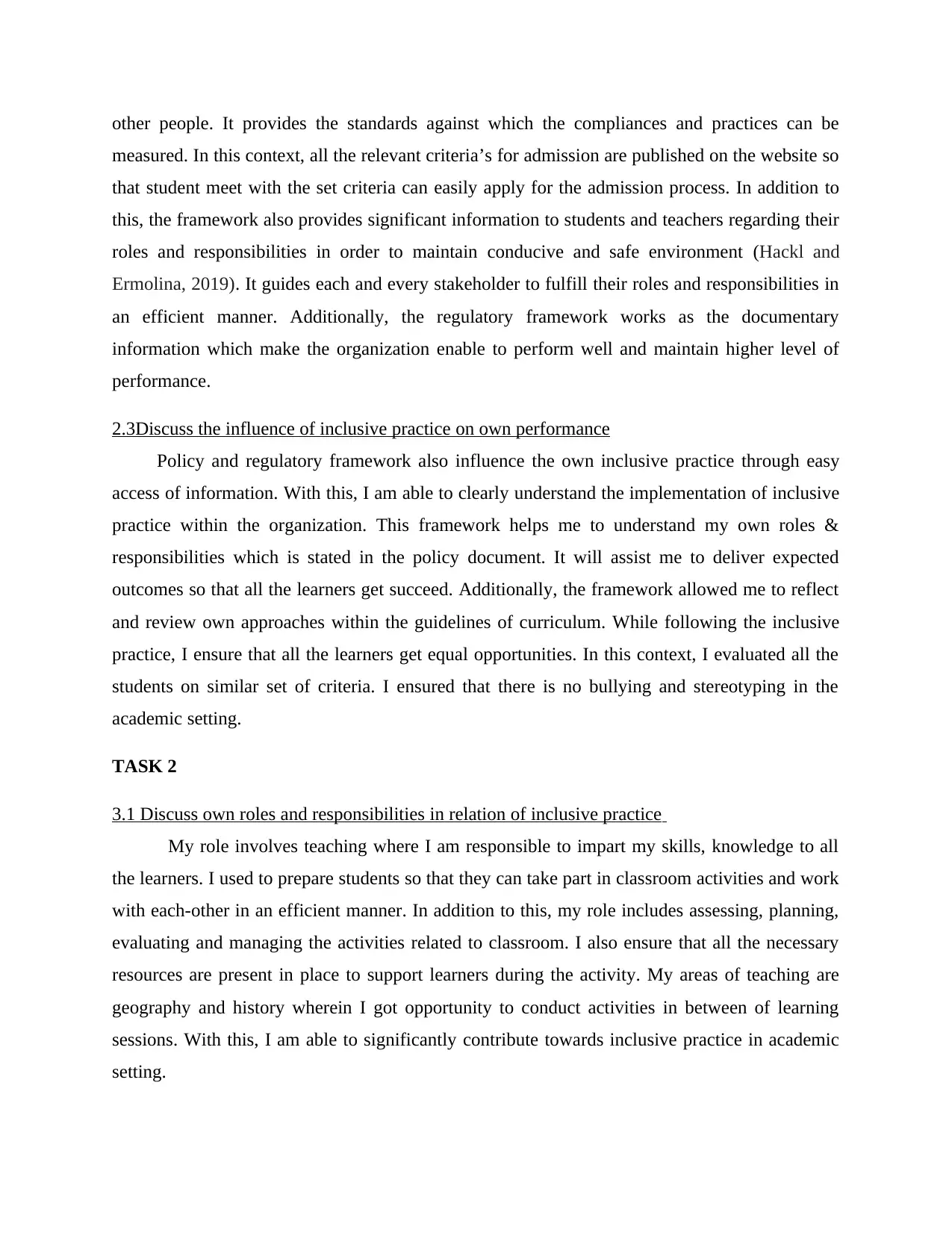
other people. It provides the standards against which the compliances and practices can be
measured. In this context, all the relevant criteria’s for admission are published on the website so
that student meet with the set criteria can easily apply for the admission process. In addition to
this, the framework also provides significant information to students and teachers regarding their
roles and responsibilities in order to maintain conducive and safe environment (Hackl and
Ermolina, 2019). It guides each and every stakeholder to fulfill their roles and responsibilities in
an efficient manner. Additionally, the regulatory framework works as the documentary
information which make the organization enable to perform well and maintain higher level of
performance.
2.3Discuss the influence of inclusive practice on own performance
Policy and regulatory framework also influence the own inclusive practice through easy
access of information. With this, I am able to clearly understand the implementation of inclusive
practice within the organization. This framework helps me to understand my own roles &
responsibilities which is stated in the policy document. It will assist me to deliver expected
outcomes so that all the learners get succeed. Additionally, the framework allowed me to reflect
and review own approaches within the guidelines of curriculum. While following the inclusive
practice, I ensure that all the learners get equal opportunities. In this context, I evaluated all the
students on similar set of criteria. I ensured that there is no bullying and stereotyping in the
academic setting.
TASK 2
3.1 Discuss own roles and responsibilities in relation of inclusive practice
My role involves teaching where I am responsible to impart my skills, knowledge to all
the learners. I used to prepare students so that they can take part in classroom activities and work
with each-other in an efficient manner. In addition to this, my role includes assessing, planning,
evaluating and managing the activities related to classroom. I also ensure that all the necessary
resources are present in place to support learners during the activity. My areas of teaching are
geography and history wherein I got opportunity to conduct activities in between of learning
sessions. With this, I am able to significantly contribute towards inclusive practice in academic
setting.
measured. In this context, all the relevant criteria’s for admission are published on the website so
that student meet with the set criteria can easily apply for the admission process. In addition to
this, the framework also provides significant information to students and teachers regarding their
roles and responsibilities in order to maintain conducive and safe environment (Hackl and
Ermolina, 2019). It guides each and every stakeholder to fulfill their roles and responsibilities in
an efficient manner. Additionally, the regulatory framework works as the documentary
information which make the organization enable to perform well and maintain higher level of
performance.
2.3Discuss the influence of inclusive practice on own performance
Policy and regulatory framework also influence the own inclusive practice through easy
access of information. With this, I am able to clearly understand the implementation of inclusive
practice within the organization. This framework helps me to understand my own roles &
responsibilities which is stated in the policy document. It will assist me to deliver expected
outcomes so that all the learners get succeed. Additionally, the framework allowed me to reflect
and review own approaches within the guidelines of curriculum. While following the inclusive
practice, I ensure that all the learners get equal opportunities. In this context, I evaluated all the
students on similar set of criteria. I ensured that there is no bullying and stereotyping in the
academic setting.
TASK 2
3.1 Discuss own roles and responsibilities in relation of inclusive practice
My role involves teaching where I am responsible to impart my skills, knowledge to all
the learners. I used to prepare students so that they can take part in classroom activities and work
with each-other in an efficient manner. In addition to this, my role includes assessing, planning,
evaluating and managing the activities related to classroom. I also ensure that all the necessary
resources are present in place to support learners during the activity. My areas of teaching are
geography and history wherein I got opportunity to conduct activities in between of learning
sessions. With this, I am able to significantly contribute towards inclusive practice in academic
setting.
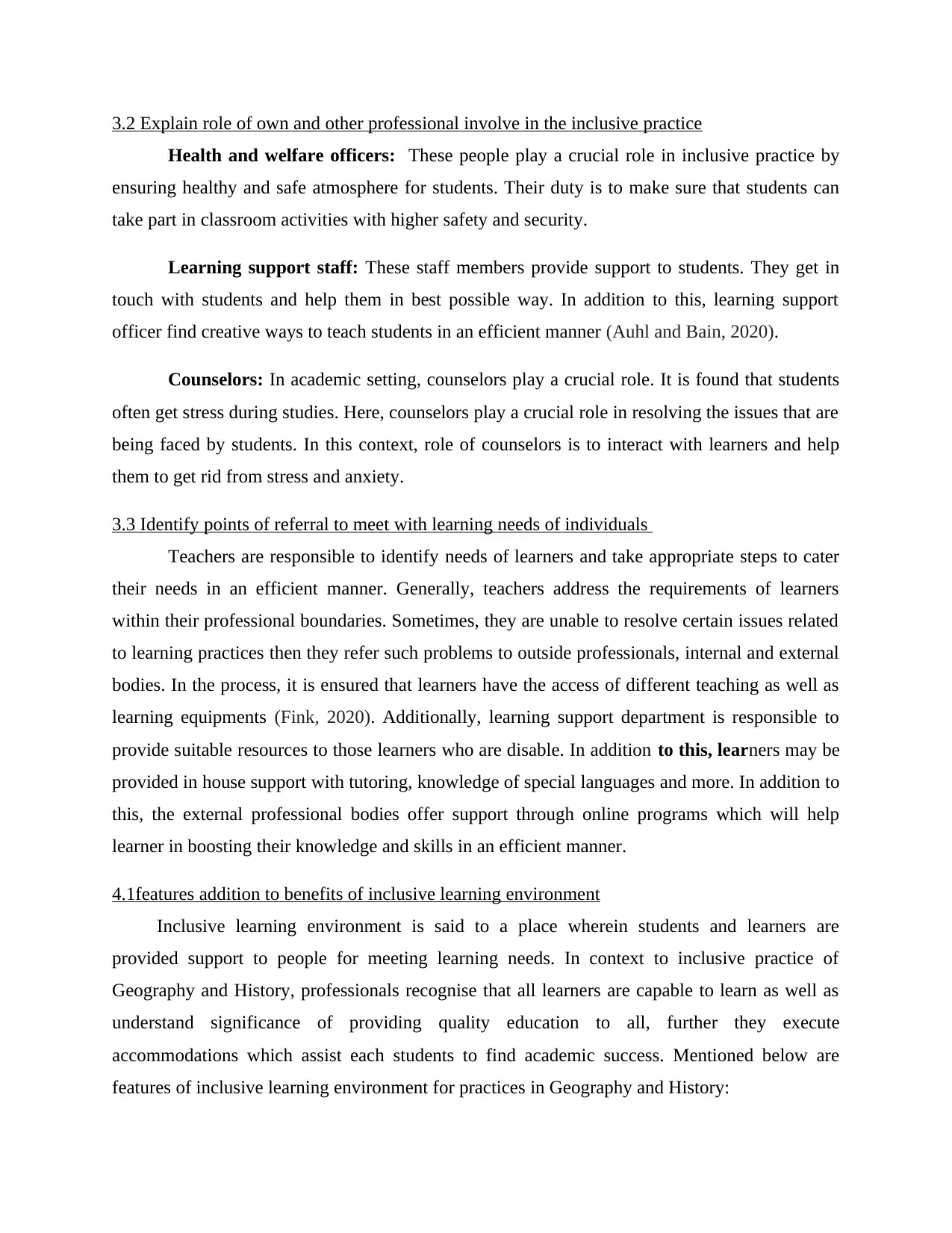
3.2 Explain role of own and other professional involve in the inclusive practice
Health and welfare officers: These people play a crucial role in inclusive practice by
ensuring healthy and safe atmosphere for students. Their duty is to make sure that students can
take part in classroom activities with higher safety and security.
Learning support staff: These staff members provide support to students. They get in
touch with students and help them in best possible way. In addition to this, learning support
officer find creative ways to teach students in an efficient manner (Auhl and Bain, 2020).
Counselors: In academic setting, counselors play a crucial role. It is found that students
often get stress during studies. Here, counselors play a crucial role in resolving the issues that are
being faced by students. In this context, role of counselors is to interact with learners and help
them to get rid from stress and anxiety.
3.3 Identify points of referral to meet with learning needs of individuals
Teachers are responsible to identify needs of learners and take appropriate steps to cater
their needs in an efficient manner. Generally, teachers address the requirements of learners
within their professional boundaries. Sometimes, they are unable to resolve certain issues related
to learning practices then they refer such problems to outside professionals, internal and external
bodies. In the process, it is ensured that learners have the access of different teaching as well as
learning equipments (Fink, 2020). Additionally, learning support department is responsible to
provide suitable resources to those learners who are disable. In addition to this, learners may be
provided in house support with tutoring, knowledge of special languages and more. In addition to
this, the external professional bodies offer support through online programs which will help
learner in boosting their knowledge and skills in an efficient manner.
4.1features addition to benefits of inclusive learning environment
Inclusive learning environment is said to a place wherein students and learners are
provided support to people for meeting learning needs. In context to inclusive practice of
Geography and History, professionals recognise that all learners are capable to learn as well as
understand significance of providing quality education to all, further they execute
accommodations which assist each students to find academic success. Mentioned below are
features of inclusive learning environment for practices in Geography and History:
Health and welfare officers: These people play a crucial role in inclusive practice by
ensuring healthy and safe atmosphere for students. Their duty is to make sure that students can
take part in classroom activities with higher safety and security.
Learning support staff: These staff members provide support to students. They get in
touch with students and help them in best possible way. In addition to this, learning support
officer find creative ways to teach students in an efficient manner (Auhl and Bain, 2020).
Counselors: In academic setting, counselors play a crucial role. It is found that students
often get stress during studies. Here, counselors play a crucial role in resolving the issues that are
being faced by students. In this context, role of counselors is to interact with learners and help
them to get rid from stress and anxiety.
3.3 Identify points of referral to meet with learning needs of individuals
Teachers are responsible to identify needs of learners and take appropriate steps to cater
their needs in an efficient manner. Generally, teachers address the requirements of learners
within their professional boundaries. Sometimes, they are unable to resolve certain issues related
to learning practices then they refer such problems to outside professionals, internal and external
bodies. In the process, it is ensured that learners have the access of different teaching as well as
learning equipments (Fink, 2020). Additionally, learning support department is responsible to
provide suitable resources to those learners who are disable. In addition to this, learners may be
provided in house support with tutoring, knowledge of special languages and more. In addition to
this, the external professional bodies offer support through online programs which will help
learner in boosting their knowledge and skills in an efficient manner.
4.1features addition to benefits of inclusive learning environment
Inclusive learning environment is said to a place wherein students and learners are
provided support to people for meeting learning needs. In context to inclusive practice of
Geography and History, professionals recognise that all learners are capable to learn as well as
understand significance of providing quality education to all, further they execute
accommodations which assist each students to find academic success. Mentioned below are
features of inclusive learning environment for practices in Geography and History:
⊘ This is a preview!⊘
Do you want full access?
Subscribe today to unlock all pages.

Trusted by 1+ million students worldwide
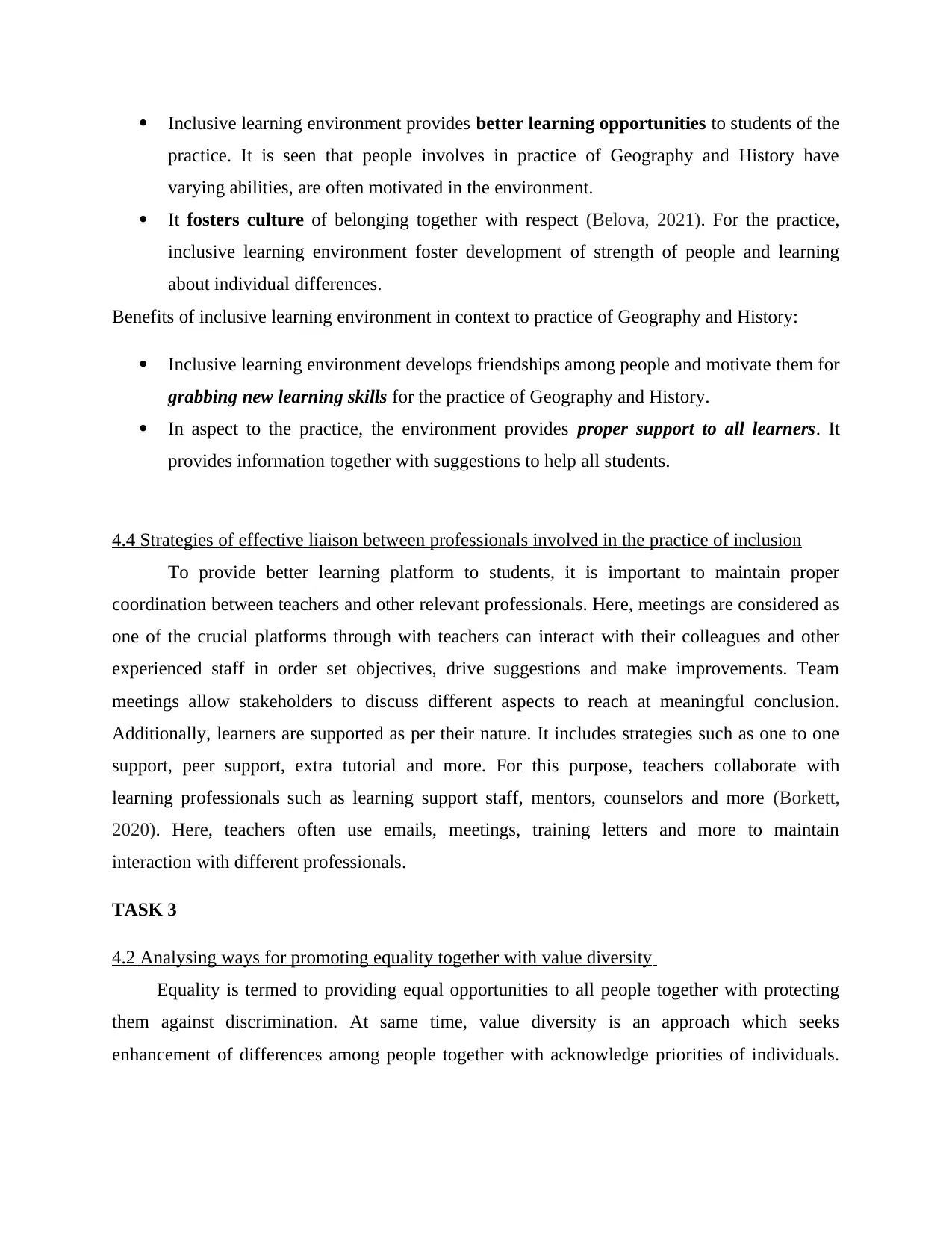
Inclusive learning environment provides better learning opportunities to students of the
practice. It is seen that people involves in practice of Geography and History have
varying abilities, are often motivated in the environment.
It fosters culture of belonging together with respect (Belova, 2021). For the practice,
inclusive learning environment foster development of strength of people and learning
about individual differences.
Benefits of inclusive learning environment in context to practice of Geography and History:
Inclusive learning environment develops friendships among people and motivate them for
grabbing new learning skills for the practice of Geography and History.
In aspect to the practice, the environment provides proper support to all learners. It
provides information together with suggestions to help all students.
4.4 Strategies of effective liaison between professionals involved in the practice of inclusion
To provide better learning platform to students, it is important to maintain proper
coordination between teachers and other relevant professionals. Here, meetings are considered as
one of the crucial platforms through with teachers can interact with their colleagues and other
experienced staff in order set objectives, drive suggestions and make improvements. Team
meetings allow stakeholders to discuss different aspects to reach at meaningful conclusion.
Additionally, learners are supported as per their nature. It includes strategies such as one to one
support, peer support, extra tutorial and more. For this purpose, teachers collaborate with
learning professionals such as learning support staff, mentors, counselors and more (Borkett,
2020). Here, teachers often use emails, meetings, training letters and more to maintain
interaction with different professionals.
TASK 3
4.2 Analysing ways for promoting equality together with value diversity
Equality is termed to providing equal opportunities to all people together with protecting
them against discrimination. At same time, value diversity is an approach which seeks
enhancement of differences among people together with acknowledge priorities of individuals.
practice. It is seen that people involves in practice of Geography and History have
varying abilities, are often motivated in the environment.
It fosters culture of belonging together with respect (Belova, 2021). For the practice,
inclusive learning environment foster development of strength of people and learning
about individual differences.
Benefits of inclusive learning environment in context to practice of Geography and History:
Inclusive learning environment develops friendships among people and motivate them for
grabbing new learning skills for the practice of Geography and History.
In aspect to the practice, the environment provides proper support to all learners. It
provides information together with suggestions to help all students.
4.4 Strategies of effective liaison between professionals involved in the practice of inclusion
To provide better learning platform to students, it is important to maintain proper
coordination between teachers and other relevant professionals. Here, meetings are considered as
one of the crucial platforms through with teachers can interact with their colleagues and other
experienced staff in order set objectives, drive suggestions and make improvements. Team
meetings allow stakeholders to discuss different aspects to reach at meaningful conclusion.
Additionally, learners are supported as per their nature. It includes strategies such as one to one
support, peer support, extra tutorial and more. For this purpose, teachers collaborate with
learning professionals such as learning support staff, mentors, counselors and more (Borkett,
2020). Here, teachers often use emails, meetings, training letters and more to maintain
interaction with different professionals.
TASK 3
4.2 Analysing ways for promoting equality together with value diversity
Equality is termed to providing equal opportunities to all people together with protecting
them against discrimination. At same time, value diversity is an approach which seeks
enhancement of differences among people together with acknowledge priorities of individuals.
Paraphrase This Document
Need a fresh take? Get an instant paraphrase of this document with our AI Paraphraser
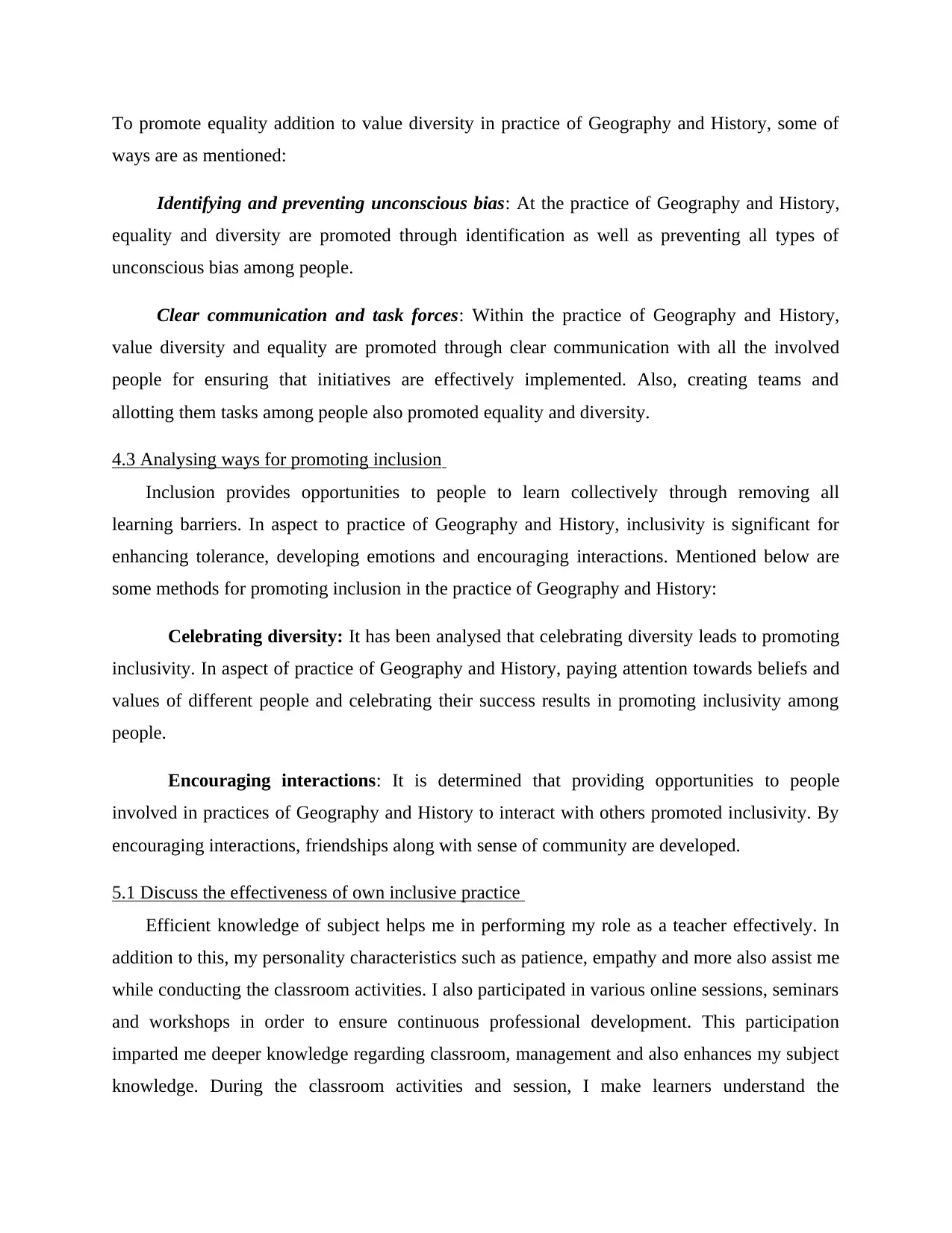
To promote equality addition to value diversity in practice of Geography and History, some of
ways are as mentioned:
Identifying and preventing unconscious bias: At the practice of Geography and History,
equality and diversity are promoted through identification as well as preventing all types of
unconscious bias among people.
Clear communication and task forces: Within the practice of Geography and History,
value diversity and equality are promoted through clear communication with all the involved
people for ensuring that initiatives are effectively implemented. Also, creating teams and
allotting them tasks among people also promoted equality and diversity.
4.3 Analysing ways for promoting inclusion
Inclusion provides opportunities to people to learn collectively through removing all
learning barriers. In aspect to practice of Geography and History, inclusivity is significant for
enhancing tolerance, developing emotions and encouraging interactions. Mentioned below are
some methods for promoting inclusion in the practice of Geography and History:
Celebrating diversity: It has been analysed that celebrating diversity leads to promoting
inclusivity. In aspect of practice of Geography and History, paying attention towards beliefs and
values of different people and celebrating their success results in promoting inclusivity among
people.
Encouraging interactions: It is determined that providing opportunities to people
involved in practices of Geography and History to interact with others promoted inclusivity. By
encouraging interactions, friendships along with sense of community are developed.
5.1 Discuss the effectiveness of own inclusive practice
Efficient knowledge of subject helps me in performing my role as a teacher effectively. In
addition to this, my personality characteristics such as patience, empathy and more also assist me
while conducting the classroom activities. I also participated in various online sessions, seminars
and workshops in order to ensure continuous professional development. This participation
imparted me deeper knowledge regarding classroom, management and also enhances my subject
knowledge. During the classroom activities and session, I make learners understand the
ways are as mentioned:
Identifying and preventing unconscious bias: At the practice of Geography and History,
equality and diversity are promoted through identification as well as preventing all types of
unconscious bias among people.
Clear communication and task forces: Within the practice of Geography and History,
value diversity and equality are promoted through clear communication with all the involved
people for ensuring that initiatives are effectively implemented. Also, creating teams and
allotting them tasks among people also promoted equality and diversity.
4.3 Analysing ways for promoting inclusion
Inclusion provides opportunities to people to learn collectively through removing all
learning barriers. In aspect to practice of Geography and History, inclusivity is significant for
enhancing tolerance, developing emotions and encouraging interactions. Mentioned below are
some methods for promoting inclusion in the practice of Geography and History:
Celebrating diversity: It has been analysed that celebrating diversity leads to promoting
inclusivity. In aspect of practice of Geography and History, paying attention towards beliefs and
values of different people and celebrating their success results in promoting inclusivity among
people.
Encouraging interactions: It is determined that providing opportunities to people
involved in practices of Geography and History to interact with others promoted inclusivity. By
encouraging interactions, friendships along with sense of community are developed.
5.1 Discuss the effectiveness of own inclusive practice
Efficient knowledge of subject helps me in performing my role as a teacher effectively. In
addition to this, my personality characteristics such as patience, empathy and more also assist me
while conducting the classroom activities. I also participated in various online sessions, seminars
and workshops in order to ensure continuous professional development. This participation
imparted me deeper knowledge regarding classroom, management and also enhances my subject
knowledge. During the classroom activities and session, I make learners understand the

significance of diversity and teach them how the need of variations in culture, religion and more.
Additionally, use of creative home work which involve different skills related to real life as well
as industrial experience make the whole learning process more meaningful and motivate learners
to learn new concepts. I used to get involve in peer discussion wherein I often use to take my
feedback from my peers and colleagues. Here, the feedback helped me to improve and enhanced
my practices as a teacher.
5.2 Identify own strengths and areas of improvements in context of inclusive practice
Assessing own performance is really crucial for a teacher. It helps in understanding the
actual position where one stands. Strengths and areas of improvements can also identify through
reflection. Additionally, it assists a person to make a suitable plan for further growth and
improvement (Rice, 2020). I am working as a teacher and I have an aim to establish inclusive
environment within the classroom so that each and every student can effectively interact with
each-other. In this context, SWOT analysis is outlined below:
Strength Weaknesses
I am able to manage time properly
which will help me in conducting
inclusive activities along with the
learning session.
My leadership abilities allow me to
guide and direct students in an
appropriate way.
I analyzed that I need to work upon my
communication skills as sometimes I am
unable to effectively communicate with
learners.
Opportunities Threats
I can enhance in my own field my
enlarging my knowledge criteria. It will
help me to make a bright and enriching
career.
By maintaining proper interaction with
students, I can easily maintain a
inclusive atmosphere within the
The changing attitude, perception of
students is the biggest threat for me as
it will create constraints in setting up
inclusive practice.
Additionally, use of creative home work which involve different skills related to real life as well
as industrial experience make the whole learning process more meaningful and motivate learners
to learn new concepts. I used to get involve in peer discussion wherein I often use to take my
feedback from my peers and colleagues. Here, the feedback helped me to improve and enhanced
my practices as a teacher.
5.2 Identify own strengths and areas of improvements in context of inclusive practice
Assessing own performance is really crucial for a teacher. It helps in understanding the
actual position where one stands. Strengths and areas of improvements can also identify through
reflection. Additionally, it assists a person to make a suitable plan for further growth and
improvement (Rice, 2020). I am working as a teacher and I have an aim to establish inclusive
environment within the classroom so that each and every student can effectively interact with
each-other. In this context, SWOT analysis is outlined below:
Strength Weaknesses
I am able to manage time properly
which will help me in conducting
inclusive activities along with the
learning session.
My leadership abilities allow me to
guide and direct students in an
appropriate way.
I analyzed that I need to work upon my
communication skills as sometimes I am
unable to effectively communicate with
learners.
Opportunities Threats
I can enhance in my own field my
enlarging my knowledge criteria. It will
help me to make a bright and enriching
career.
By maintaining proper interaction with
students, I can easily maintain a
inclusive atmosphere within the
The changing attitude, perception of
students is the biggest threat for me as
it will create constraints in setting up
inclusive practice.
⊘ This is a preview!⊘
Do you want full access?
Subscribe today to unlock all pages.

Trusted by 1+ million students worldwide
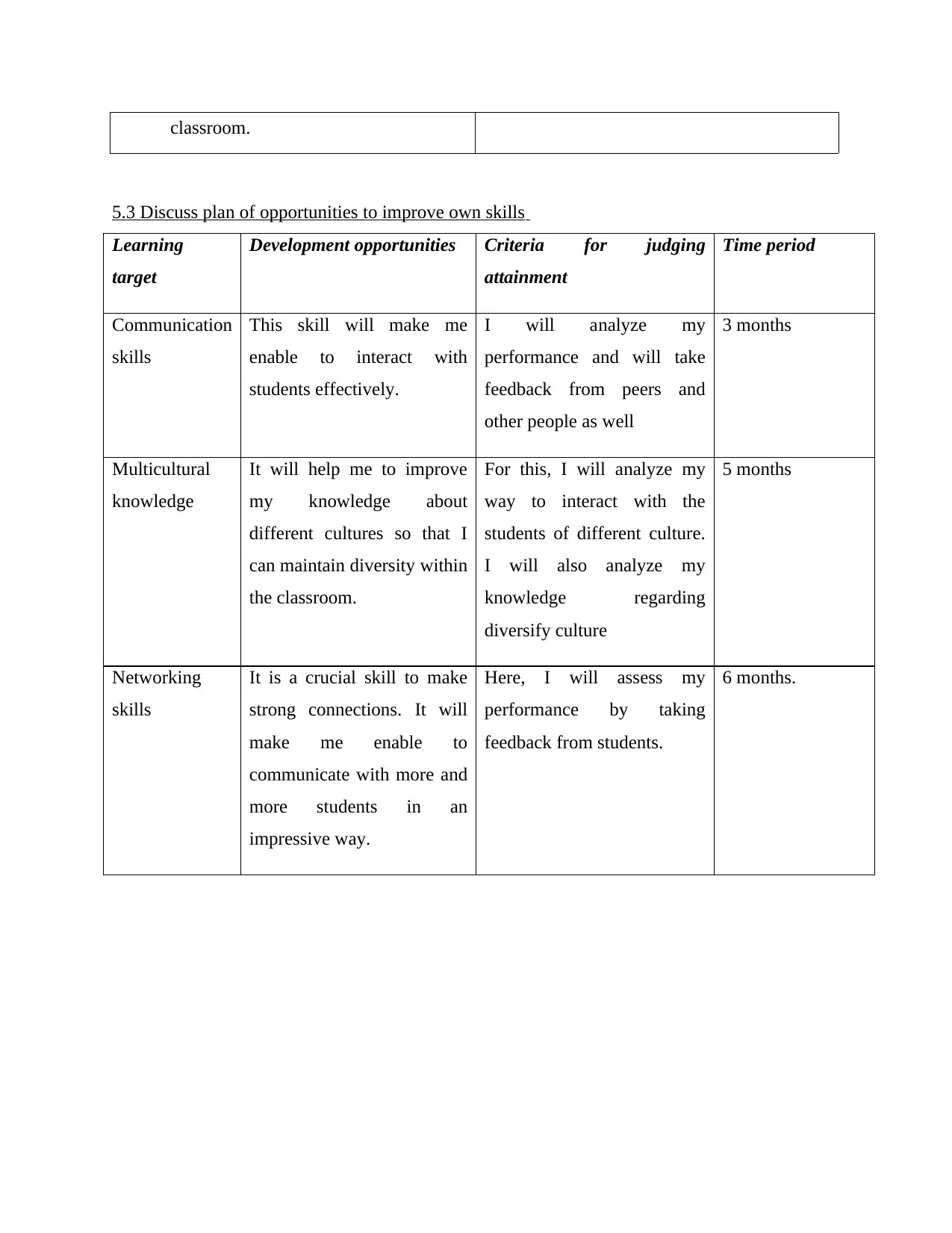
classroom.
5.3 Discuss plan of opportunities to improve own skills
Learning
target
Development opportunities Criteria for judging
attainment
Time period
Communication
skills
This skill will make me
enable to interact with
students effectively.
I will analyze my
performance and will take
feedback from peers and
other people as well
3 months
Multicultural
knowledge
It will help me to improve
my knowledge about
different cultures so that I
can maintain diversity within
the classroom.
For this, I will analyze my
way to interact with the
students of different culture.
I will also analyze my
knowledge regarding
diversify culture
5 months
Networking
skills
It is a crucial skill to make
strong connections. It will
make me enable to
communicate with more and
more students in an
impressive way.
Here, I will assess my
performance by taking
feedback from students.
6 months.
5.3 Discuss plan of opportunities to improve own skills
Learning
target
Development opportunities Criteria for judging
attainment
Time period
Communication
skills
This skill will make me
enable to interact with
students effectively.
I will analyze my
performance and will take
feedback from peers and
other people as well
3 months
Multicultural
knowledge
It will help me to improve
my knowledge about
different cultures so that I
can maintain diversity within
the classroom.
For this, I will analyze my
way to interact with the
students of different culture.
I will also analyze my
knowledge regarding
diversify culture
5 months
Networking
skills
It is a crucial skill to make
strong connections. It will
make me enable to
communicate with more and
more students in an
impressive way.
Here, I will assess my
performance by taking
feedback from students.
6 months.
Paraphrase This Document
Need a fresh take? Get an instant paraphrase of this document with our AI Paraphraser

Conclusion
After going through with above-mentioned information, it is assessed that inclusive
practice is crucial in academic setting in order to facilitate sense of belonging, friendship and
inclusion among learners. Discussion has been carried out regarding influence of physical,
sensory abilities on learning. Additionally, it is found that personal, cultural as well as social
factors affect learning process in an efficient manner. It is concluded that I am working as a
teacher in the field geography and history. I have been identified my strong as well as weak areas
and have been develop a suitable plan to facilitate inclusion in academic setting.
After going through with above-mentioned information, it is assessed that inclusive
practice is crucial in academic setting in order to facilitate sense of belonging, friendship and
inclusion among learners. Discussion has been carried out regarding influence of physical,
sensory abilities on learning. Additionally, it is found that personal, cultural as well as social
factors affect learning process in an efficient manner. It is concluded that I am working as a
teacher in the field geography and history. I have been identified my strong as well as weak areas
and have been develop a suitable plan to facilitate inclusion in academic setting.

References
Books and journals
Auhl, G. and Bain, A., 2020. Do pre-service teachers develop a schema for inclusive classroom
practice?. Asia-Pacific Journal of Teacher Education, pp.1-17.
Belova, T., 2021, June. Using the Principles of Neurolanguage Coaching and Brain Friendly
Techniques in Foreign Language Teaching in the Inclusive Learning Environment.
In 1st International Conference on Education: Current Issues and Digital Technologies
(ICECIDT 2021) (pp. 419-423). Atlantis Press.
Borkett, P., 2020. Special Educational Needs in the Early Years: A Guide to Inclusive Practice.
SAGE.
Cocks, J., 2019. Family Inclusive practice in child welfare: report of a Churchill Fellowship
study tour. Children Australia, 44(4), pp.202-211.
Fink, K., 2020, August. “When Making is Inclusive, Good Things Happen”–Really? Why
Diversity is Problematic, and Why an Inclusive Practice Might Re-Politicize the
Museum. In Diversity Gains (pp. 105-124). Nomos Verlagsgesellschaft mbH & Co. KG.
Finkelstein, S., Sharma, U. and Furlonger, B., 2021. The inclusive practices of classroom
teachers: a scoping review and thematic analysis. International Journal of Inclusive
Education, 25(6), pp.735-762.
Hackl, E. and Ermolina, I., 2019. Inclusion by design: Embedding inclusive teaching practice
into design and preparation of laboratory classes. Currents in Pharmacy Teaching and
Learning, 11(12), pp.1323-1334.
Heck, S. and Block, M.E. eds., 2019. Inclusive physical education around the world: Origins,
cultures, practices. Routledge.
Layer, G., 2019. From national policy to university practice: Developing an inclusive learning
environment within and beyond the United Kingdom. In Transforming Higher
Education Through Universal Design for Learning (pp. 33-49). Routledge.
Rice, B.M., 2020. Opportunities for Inclusive Practice: The Stories Our Students Tell.
In Inclusive Education Is a Right, Right? (pp. 132-144). Brill Sense.
Sargeant, J., 2018. Towards Voice‐Inclusive Practice: Finding the Sustainability of Participation
in Realising the Child's Rights in Education. Children & Society, 32(4), pp.314-324.
Whitters, H.G., 2018. Attainment and Executive Functioning in the Early Years: Research for
Inclusive Practice and Lifelong Learning. Routledge
Books and journals
Auhl, G. and Bain, A., 2020. Do pre-service teachers develop a schema for inclusive classroom
practice?. Asia-Pacific Journal of Teacher Education, pp.1-17.
Belova, T., 2021, June. Using the Principles of Neurolanguage Coaching and Brain Friendly
Techniques in Foreign Language Teaching in the Inclusive Learning Environment.
In 1st International Conference on Education: Current Issues and Digital Technologies
(ICECIDT 2021) (pp. 419-423). Atlantis Press.
Borkett, P., 2020. Special Educational Needs in the Early Years: A Guide to Inclusive Practice.
SAGE.
Cocks, J., 2019. Family Inclusive practice in child welfare: report of a Churchill Fellowship
study tour. Children Australia, 44(4), pp.202-211.
Fink, K., 2020, August. “When Making is Inclusive, Good Things Happen”–Really? Why
Diversity is Problematic, and Why an Inclusive Practice Might Re-Politicize the
Museum. In Diversity Gains (pp. 105-124). Nomos Verlagsgesellschaft mbH & Co. KG.
Finkelstein, S., Sharma, U. and Furlonger, B., 2021. The inclusive practices of classroom
teachers: a scoping review and thematic analysis. International Journal of Inclusive
Education, 25(6), pp.735-762.
Hackl, E. and Ermolina, I., 2019. Inclusion by design: Embedding inclusive teaching practice
into design and preparation of laboratory classes. Currents in Pharmacy Teaching and
Learning, 11(12), pp.1323-1334.
Heck, S. and Block, M.E. eds., 2019. Inclusive physical education around the world: Origins,
cultures, practices. Routledge.
Layer, G., 2019. From national policy to university practice: Developing an inclusive learning
environment within and beyond the United Kingdom. In Transforming Higher
Education Through Universal Design for Learning (pp. 33-49). Routledge.
Rice, B.M., 2020. Opportunities for Inclusive Practice: The Stories Our Students Tell.
In Inclusive Education Is a Right, Right? (pp. 132-144). Brill Sense.
Sargeant, J., 2018. Towards Voice‐Inclusive Practice: Finding the Sustainability of Participation
in Realising the Child's Rights in Education. Children & Society, 32(4), pp.314-324.
Whitters, H.G., 2018. Attainment and Executive Functioning in the Early Years: Research for
Inclusive Practice and Lifelong Learning. Routledge
⊘ This is a preview!⊘
Do you want full access?
Subscribe today to unlock all pages.

Trusted by 1+ million students worldwide
1 out of 12
Related Documents
Your All-in-One AI-Powered Toolkit for Academic Success.
+13062052269
info@desklib.com
Available 24*7 on WhatsApp / Email
![[object Object]](/_next/static/media/star-bottom.7253800d.svg)
Unlock your academic potential
Copyright © 2020–2025 A2Z Services. All Rights Reserved. Developed and managed by ZUCOL.



